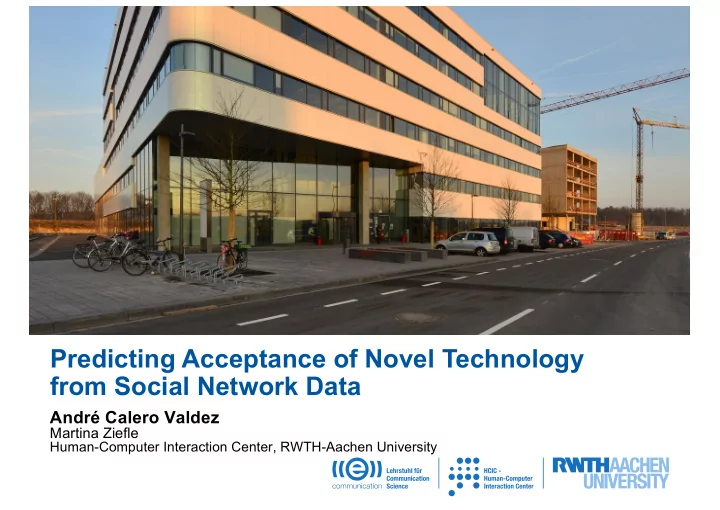

Predicting Acceptance of Novel Technology from Social Network Data André Calero Valdez Martina Ziefle Human-Computer Interaction Center, RWTH-Aachen University
The unprepared transformation Industrie 4.0 and SMEs • A large amount of SMEs are are not making progress • Where to start? • Technology infrastructure • Cybersecurity • Required Capabilities • Lack of Talents • Technological and social resources
The Industrie 4.0 worker and engineer A complex set of attributes • Attitude towards digitization • High level of skills with IT - in cybersecurity - in network and decentralized thinking - in technology frameworks and dynamics • Etiquette of ICT • Culture of digitization • Acceptance of novel technology Photo Credit: Alamy What drives acceptance? How can we predict acceptance?
Technology Acceptance Research Theories and models since the 60s • Technology Acceptance Model - TAM (1-3) • Unified Theory of acceptance and use of Technology - UTAUT (1-2) • Theory of reasoned action, theory of planned behavior • Theory of Diffusion of Innovations (Rogers 1962)
UTAUT vs. Diffusion of Innovations (DOI) Static vs. dynamic model DOI UTAUT Focus on societal acceptance Focus on individual acceptance
Bring both models together for prediction Static traits vs. context dependent perceptions • Some characteristics are relatively stable, others change with context - Static traits can be measured once - Context dependent perceptions need constant reevaluation • Social Influence changes most drastically with context - ”People that are important to me, also use the software/tool/etc.” • Social structure of an organization can be inferred from proxy data - Shared projects, shared offices, shared authorship • Experiment: - Can we measure static traits once and predict behavior using simulated context dependent perceptions from proxy data? - Can we predict whether people use a software from common co-authorships?
Agent-based modelling Modelling user behavior individually
Batch-Simulation 161,051 Randomized local start conditions Average simulated mean is lower than true mean Histogram of mean behavioral intention of all runs (n=161,051) 10000 − 1 standard deviation +1 standard deviation True mean of sample 7500 Frequency 5000 2500 0 1 2 3 4 5 6 Predicted behavioral intention Data is based on full range of path − coefficients [0;1]
True model parameters help Integrating model parameters from previous research True coefficients match better Histogram of mean behavioral intention (n=539) 80 60 Frequency − 1 SD +1 SD M 40 20 0 1 2 3 4 5 6 Predicted behavioral intention
Using larger scale artificial data Prediction of 500 employee company No ground truth Effect of Network Density on Diffusion 100 Percentage of people reaching a BI > 3.5 75 50 25 0 25 50 75 100 Density of network Network size=500 Simulations = 91000
Discussion Agent-based modelling as a means to predict acceptance • Agent-based models help with individual differences in prediction • Allow identification of gate-keepers for acceptance • Data proxies can differ in quality w.r.t. true social relations • Storing personal data has strong regulations (GDPR) • Ethical and legal considerations - Digital Human Modelling of individuals - Anonymization of data - Loss of competitiveness if ignored
Thank you for your attention Predicting Acceptance of Novel Technology from Social Network Data • Technology Acceptance models suffer from static limitations • Agent-based models can combine static and dynamic aspects • Prediction quality is high True coefficients match better Histogram of mean behavioral intention (n=539) 80 60 Frequency − 1 SD +1 SD M 40 20 Dr. André Calero Valdez 0 RWTH Aachen University 1 2 3 4 5 6 calero-valdez@comm.rwth-aachen.de Predicted behavioral intention
Recommend
More recommend